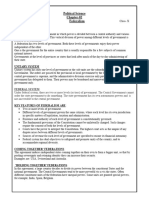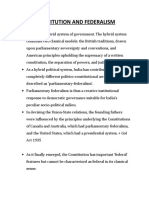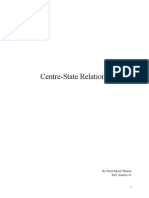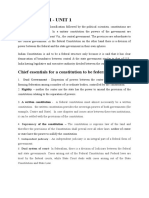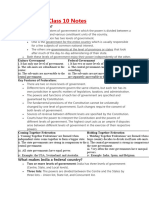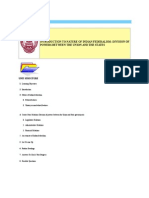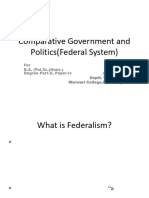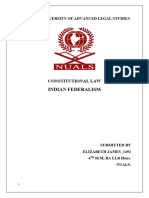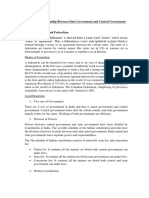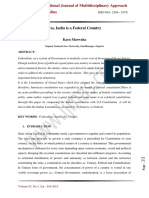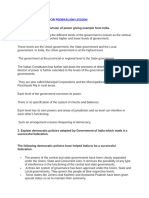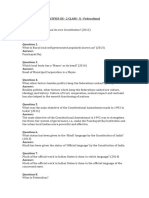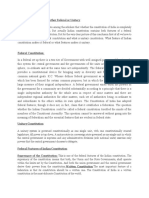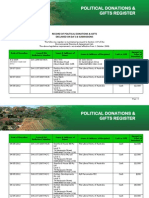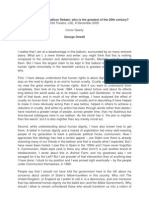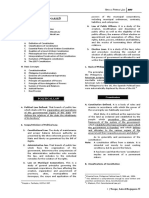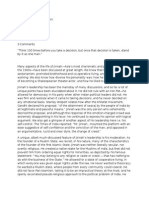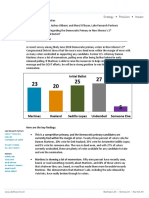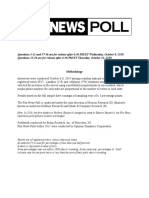Sumedha Bharpilania Journalism Hons (1St Year) : What Is Federalism?
Sumedha Bharpilania Journalism Hons (1St Year) : What Is Federalism?
Uploaded by
Sumedha BharpilaniaCopyright:
Available Formats
Sumedha Bharpilania Journalism Hons (1St Year) : What Is Federalism?
Sumedha Bharpilania Journalism Hons (1St Year) : What Is Federalism?
Uploaded by
Sumedha BharpilaniaOriginal Title
Copyright
Available Formats
Share this document
Did you find this document useful?
Is this content inappropriate?
Copyright:
Available Formats
Sumedha Bharpilania Journalism Hons (1St Year) : What Is Federalism?
Sumedha Bharpilania Journalism Hons (1St Year) : What Is Federalism?
Uploaded by
Sumedha BharpilaniaCopyright:
Available Formats
SUMEDHA BHARPILANIA JOURNALISM HONS (1st YEAR)
COMMENT ON THE INDIAN FEDERAL STRUCTURE, WITH RESPECT TO DEMANDS FOR GREATER AUTONOMY AND STATE REORGANIZATION IN ANY ONE REGION IN INDIA:
WHAT IS FEDERALISM? In modern democracies, the vertical division of power among different levels of governments is one of the major forms of power sharing. This is most commonly referred to as federalism. As Michael S.Greve said: The federalism I have in mindreal federalism aims to provide citizens with choices among diff erent sovereigns, regulatory regimes, and packages of government services ... .The citizens' ability to vote with their feet and to take their talents and assets elsewhere will discipline government in the same way in which consumer choice, in nonmonopolistic markets, disciplines producers. Federalism is a form of government in which the sovereign authority of political power is divided between the various units. This form of government is also called a "federation" or a "federal state" in the common parlance. These units are Centre, state and panchayats or the municipalities.The centre also is called union. The component units of the union are called variously as states as in the United States of America. Literally the word 'federal' means contractual. In federal system, the central government cannot order the state government to do something as state governments has powers of its own for which it is not answerable to the central government. Both these two different forms of governments are separately answerable to the people of their country. KEY FACTORS OF FEDERALISM The key factors of federalism are listed below: 1.In federalism, there are two or more levels or tiers of governments. 2.In federalism, different levels or tiers of governments govern the same citizens. Each tier or level of government has its own jurisdiction pertaining to the matters of legislation, taxation and administration. 3.In federalism, the existence and authority of each level or tier of government is constitutionally guaranteed as the jurisdiction of the respective levels or tiers of governments are specified in the constitution. 4.One level or tier of government cannot unilaterally change the fundamental provisions of the constitution as such changes require the consent of both the levels or tiers of government.
5.If disputes arise between the two tiers or levels of government in their exercise of power then highest court acts as an umpire. The courts have the power and authority to intervene into the matter and interpret the constitution and the powers of different levels of governments. 6.For each level of government, sources of revenue are clearly specified to ensure its financial autonomy. 7.The most important factors of federalism can be broadly divided into its important features. Firstly, federalism safeguards and promotes the unity of country. Secondly, it accommodates regional diversity to facilitate unity amongst citizens of the country. It builds trust between both levels of government and works as an agreement to live together in peace and harmony. What makes India a federal country? Federalism in India has some similarities with that of U.S.A. The Constitution of India like the Constitution of U.S.A, which is the oldest federation, no where uses the term "federation " or "federal union". Both countries have dual polity - one for the Central Union government and another for the state govenment. But there are two main differences between them. A person in USA has dual citizenship- one of the states where he resides and another the citizenship of his/her country U.S.A. There is no dual citizenship in India. Besides, apart from tlne constitution for the USA,: each state has its own constitution. But these are loosely interrelated. In India there is only single constitution for the whole country, with the exception of the state of Janmu and Kashmir. The Article 1 of the Constitution of India describes India as a ''Union of states" for Indian federalism. The word "Union" has been used because according to Ambedkar the "federation in India was not a result of an agreement between different states to join a Federation". The federation of India is a result of the devolution of power, not the result of an agreement. This does not give a state the right to secede from India. But the pattern of division of power under the Constitution renders it a federal character. This federal character was given by the framers of the Constitution primarily for two reasons: 8.A federal state is more effective than a unitary one when tlie size of its territory is as large as India 2. A federal state is lnclre effective than a unitary one when diverse groups of its population live in a discrete territorial concentration as in India. India got its independence in 1947 but it also resulted in painful partition that paved way to the formation of Pakistan. After independence, several princely states became a part of the country and the constitution declared India as a Union States. Despite the fact that the word federalism is not used or implied with Indian Union but it is largely based on the principles of federalism. All the above key features of federalism are well suited to the provisions of the Indian Constitution. The constitution of India provided two tiers of levels of governments Central or Union Governments representing the Union of India and the state governments. Later, a third tier or level of federalism was formed and added in the
forms of Panchayats and Municipalities. These three different tiers of governments enjoy separate jurisdictions and the constitution provides a three fold distribution of legislative powers between the Union governments and the state governments. It comprises of three major lists and they are as follows: 9.Union List: - This list includes subjects of national importance such as defence, foreign affairs, banking, communications and currency. They form as the part of Union list as we need a uniform policy on these important matters throughout the country. Union or Central government can only make laws relating to these above mentioned important subjects. 10.State List: - This list contains subjects of state and local significance and state governments alone can make laws relating to subjects like police, trade, commerce, agriculture and irrigation. 11.Concurrent List: - It can also be termed as co-existing list and includes subjects of common interest to both the Union Government as well as the State Governments. It includes subjects like education, forest, trade unions, marriage, adoption and succession. Both levels of government (Union and State governments) can make laws on these subjects. If their laws conflict with each other then the law made by the Union Government will reign and succeed. There are still other subjects that dont fall in any of these lists. According to our constitution, Union government has the power to legislate on these left over or untapped subjects. Generally, it is learnt that holding together federations do not give equal power to its constituents so all states in Indian Union does not have identical powers. Jammu and Kashmir has its own constitution and enjoys special status and many provisions of Indian constitution are not applicable in this state. There are some units of Indian Union that enjoys very little power and these are areas which are too small to be recognized as an Independent state and could not merged with any other states. They are referred to as Union Territories and include areas like Chandigarh, Lakshwadeeep and Delhi, capital city of India. The Central Government runs these areas with their special powers. It is not easy to make changes to the power sharing arrangements of Union and state governments as it has to be passed with both the houses of parliament with at least two-third majority. After its approval from both the houses of parliament, it has to be authorized or ratified by the legislatures of at least half of the total seats. In case of disputes about the division of powers, the High court and Supreme Court makes the decisive decision. Both Union and State governments have the power to raise resources by imposing taxes in order to carry on the government and the tasks allocated to them. A foreign critic Prof. K C Wherare in his book Federal Government (1951) has written that ''The Indian Constitution provides a system of government which is quasi-federal ...a unitary state with subsidiary federal features rather than a federal state with subsidiary unitary features.'' How is Federalism practiced? The success of federalism in India cannot be merely attributed to constitutional provisions but to the nature of democratic politics in our country. It ensured that the spirit
of federalism, respect for diversity and desire for living together became a common goal in our country. The major reasons in which federalism has succeeded in our country are as follows: 12.Linguistic states: - The formation of linguistic states was the first major test for democratic politics in India. There were lots of changes in democratic politics of our country from 1947 to 2006. In India, many old states have vanished while many states have been created. Even the names of areas, boundaries and states were changed during this period. In 1947, the year of independence, the boundaries of many old states were changed in order to create new states. It was done to ensure that the people speaking same language should reside in same state. It led to formation of some states that were created not on the basis of language but to recognise differences based on culture, ethnicity or geography. It includes states like Nagaland, Uttarakhand and Jharkhand. 13.Language policy: - Our constitution has not given the status of national language to any one language. Language policy proved second major test for India federation and finally Hindi was identified as the official language of the country. Hindi, the official language of country proved to be mother tongue of only 40 percent of India and therefore there were many safeguards to protect other languages. Besides Hindi, constitution recognized 21 another languages as scheduled languages. All the states had their own official language and much of government work took place in the official language of the concerned states.According to Indian constitution, the usage of English for official use has to be stopped by 1965 but many non-Hindi speaking states resented it violently and wanted to continue with English. 14.Centre State Relations: - The concept of federalism was strengthened to large extent by restructuring of centre and state governments relationships. It also largely depends on how the leaders of ruling party follow these arrangements. In India, the same party ruled both at the centre and at the most of the states. It means that the state governments did not exercise their rights as autonomous federal units. There were occasions where the parties at centre and state were different and in such cases central government tried to undermine the powers of state government. In those days, central government misused the constitution to dismiss the state governments that were governed by opposition parties. It undermined the spirit of federalism to large extent. However,federal power sharing holds more significance in todays time than in early years when constitution came into force. Decentralisation in India India is a vast country with various religions, regions, caste, areas and boundaries, so it cannot be run by two-tiers of governments. In terms of population and area, the states of India are as large as independent countries of Europe. Many states of India are very diverse and so there was need for power sharing within the state. The federal power sharing in India needed another tier of level of government that could work below state governments. This formed the foundation or basis for decentralisation of power. It resulted into third tier or level of government called local government. The word decentralisation means
when power is taken away from central and state government and given to local government. The basic idea behind decentralisation was to solve problems and issues of residing citizens that can be best solved at local level. It was easy to participate and manage domestic issues at local level and even decision making become easier. It helped to instruct a habit of democratic participation. The importance and need for decentralisation was recognized by our constitution and there were several attempts to decentralise power to the level of villages and towns. In villages, it resulted in the form of panchayats while municipalities were set up in urban areas of town and city in all the states. Both panchayats and municipalities were directly under the control of state governments. These local governments did not have any power or resources of their own and elections to these governments were not held regularly. The decentralisation was very little in effective terms but major steps were taken in 1992. The constitution was amended to make local government or the third tier of government more powerful and effective. Thus to quote Ajay Kumar Singh ''Indian federalism is the simultaneity of two processes the unionization process and the regionalization process'' Demand for greater autonomy for the states:.4 Demand for Greater The founding fathers of the Indian Constitution were deeply concerned about ensuring the unity and integrity of the country. They were aware of the forces of disruption and disunity working within the country. These dangers at the time of independence could be handled only by a strong government at the Centre.Therefore, the framers of the Constitution assigned a predominant role to the Centre. At the same time they made provisions for the establishment of a co-operative federalism.The working of the Indian federation during the last five decades clearly shows that the relations between the Centre and the States have not always been cordial.The administrative Reforms Commission and several other Commissions were appointed by the Government of India from time to time to regulate Centre State relations. The Union Government appointed Sarkaria Commission to suggest ways and means to improve Centre-State relations. The recommendations of the Sarkaria Commission assume importance so as to evolve an appropriate policy in the areas of legislative, administrative and financial relations. It has not suggested wholesole structural changes in the fundamental fabric of the Constitution.It felt that federalism is more a functional arrangement for co-operative action than a static institutional concept. The Commission strongly recommended the establishment of permanent Inter-State Council. In addition, it desired that both the Centre and the States should have the concern for the development of backward territory or areas. If the economic development of these backward regions are undertaken in a planned manner, the separatist tendencies will be automatically controlled. Differences between the Union and the States should be resolved by mutual consultation. It has taken a favourable view on the demand of the States to provide more financial resources at their disposal. In order to improve Centre-State relations in the country, it has suggested economic liberalization and suitable amendments to the Constitution. We shall now look at the demand for greater autonomy by a particular state by virtue of a
case study. We have focused our attention on the state of Telangana in this case: TELANGANA: Over the past decade a movement for separate statehood has been going on in Telengana. The nature and the socio-economic context of the movement for statehood is not fully appreciated outside the region though it offers so may possibilities to explain different dimensions of the Indian political system. Before 1947, Telangana was part of the Hyderabad State.The princely state of Hyderabad under the Nizam consisted of three linguistic regions:Marathi, Kannada and Telugu. Telangana the Telugu speaking region of Hyderabad has acquired distinct identity and history. In 1948 the union government integrated the Nizam state into the Indian union after an armed action popularly known as the Police Action. Later it was further integrated with the Telugu speaking region of the Andhra region, which was a part of the Madras Presidency until 1953. The demand to preserve the identity of the region with the creation of a separate state started immediately after independence in reaction to the treatment meted out to Hyderabad by the central government. People thought that their socio-economic conditions would improve after the integration of the region into the Indian union. But they were disappointed and disillusioned with the administration. After Police Action, officials were brought here from the coastal districts and the districts of the then Madras Presidency, for administrative convenience.1 These officials displayed a condescending attitude towards the local people and treated Hyderabad as an occupied territory. N M Jaisoorya who was a member of parliament in the early 1950s from Hyderabad noted, People have been looted apart from being oppressed and insulted by the outside officials. This behaviour led to an agitation against nonmulkis (outsiders) in August 1952. The agitation known popularly as the mulki movement lasted for over one month.Students from all over the region actively participated in the movement which was suppressed by the authorities. The 1952 agitation is significant because it shaped the attitude of the people towards the issue of state reorganisation. Though the demand for a separate Telangana state had its roots in the Mulki movement it was not articulated by the political groups until the question of state reorganisation became a reality. REASONS FOR TELANGANA TO BE A SEPARATE STATE: Here is what the website www.telengana.org has to say about the need for a separate Telangana: ''There are several reasons for demanding a separate state of Telangana. But, let us list a few: Telangana was a separate state before 1956. Telangana people want self-respect, self-governanceand development, as the postmerger in 53 years.The area is managed by Andhra and Rayalaseema leadership and systematically the Telangana economy is weakened and collapsed. Though the language spoken is Telugu which is common,the dialect in Telangana is different from the other regions and there is a cltural diversity.
In terms of total area, Telangana region is bigger than 18 states in India (Assam, Nagaland, Meghalaya, Tripura, Arunachal Pradesh, Sikkim, Jharkhand, Uttaranchal, J&K, Mizoram, Himachal Pradesh, Haryana, Punjab, Goa, Chhattisgarh, Manipur, West Bengal and Kerala) and 60 countries in the world. The Population of Telangana is more than 3.5 Crores. The people here are deprived of their fair share under the dominance of Andhra/Rayalaseema rulers who ruled for 47 years out of 53 years of AP formation. Since, last 5 decades, the Telangana movement is alive and people aspire to be in a separate state as they are deprived of their fair share in education, employment, resource allocation, finance, facilities, and in all spheres. Telangana demand is not for separation from the Nation, but it is a genuine and democratic demand of its people for restoration of erstwhile Hyderabad (Telangana) state. More than anything else, it was the students and youth who raised the banner of revolt against their systems and political regimes. Telangana leadership and people want self-governance wherein they will be able to fully utilize their latent talent and using the natural resources in the region they will be able to fully exploit them and ensure a growth model for the new state. Muslim community constitute a major population in Telangana. In the erstwhile Hyderabad state, about 40% of the employees were muslims, and today, they are hardly 2 to 3 percent With the Telangana State, not only self-respect and selfgovernance, the people will have increased opportunities of education, and employment. In letter and spirit all the Agreements, Accords, Formulas, G.Os, Presidential Orders, Plans and Assurances on the floor of Legislature and Lok Sabha, and court orders in the last 53 years are dishonoured, and Telangana was forced to remain neglected, exploited and backward. The experiment to remain as one state proved to be a futile exercise and therefore, separation is found to be the best solution. In united Andhra Pradesh, the Telangana weaker sections, minority, and women could not have their voice heard and their problems are unattended. The State of Telangana does not require any special money for the construction of its State capital city, as the centuries-old Hyderabad is located in the heart of Telangana itself. Telangana people waited patiently for last 50 years. Nothing happened but this discrimination increased. IT IS THE DUTY OF ALL TELANGANA PEOPLE to see that our next generations don't suffer the similar fate. The saga of the Telangana struggle continues unabated, and there is no end in sight! It is immaterial if the movement is led by KCR of the TRS today or any other leader tomorrow, for that matter. Ultimately, the democratic component of the Telangana demand will keep the Jai Telangana movement alive in the days and years to come. Historically speaking, the Constitution of India has a provision, under Article 3, which facilitated the creation of at least one dozen new States in the last 50 years, and that too without the recommendation of any States Reorganisation Commission (SRC). Irrespective of the opinion of the concerned parent State, the provision empowers Parliament to alter the boundaries of any State, if such a demand is found to be democratic and popular. ''
Telangana has thus been converted into an internal colony as a result of the economic development process pursued by successive governments. Its resources have been diverted and utilised for the development of other regions. The movement for separate statehood seeks to articulate the demand for a fair share in the resources. It is an outcome of injustice meted out to the region by the successive governments in Andhra Pradesh. Separation is seen as the only answer to these gievances. Since all the political parties as well as the administrative machinery are dominated by the coastal Andhra lobbies, there is no space for the people of the Telangana region in the political arena to articulate their grievances. In view of this situation, the movement for statehood emerged outside the political arena in the realm of civil society. It originated due to the efforts made by the middle class intellectuals and social activists.Political leaders responded to the demand only after the movement gained wide support from the people.The present phase of the movement led by various civil society groups started in 1989 and intensified from 1996 onwards. The Telangana Rashtra Samithi (TRS) was formed only in 2001, after the movement gained strength. It has given political expression to the movement. The civil society groups are active even now without joining the TRS, thus providing sustenance to the movement. The movement has now gained wide support among the people of Telangana. In the recent by-elections to the Karimnagar parliamentary constituency, located in the Telangana region, people voted for TRS irrespective of their political affiliations only to show that they support the demand for separate Telangana. Even in the 2004 elections people expressed unambiguous support for the Telangana demand. In response to popular demand, 30 political parties, having a strength of 299 members in Parliament, declared their support for the formation of the Telangana state. Yet, the Congress Party heading the UPA is not able to deliver a decision on the issue. The party seems to be more concerned about the support from the Andhra elite rather than the aspirations of the Telangana people. The current movement for Telengana is certainly caused not only by economic and political reasons, but also by the revulsion in the social and cultural spheres. The hegemony as a term itself is full of cultural connotations. And in the case of Telengana the present situation requires the term in its full meaning. The ongoing anger of Telengana people and the movement requires a social, politicalsociological and cultural explanation as does a political economy explanation. So far the reddy politicians of Rayalaseema and the kamma political entrepreneurs of coastal Andhra have been together able to contain, deflect or suppress the movement for Telengana by making up in their ranks. This time around things may be different. CONCLUSION: By and large, federalism has proved to be a suitable form of government of India despite some incidents of friction between the center and the states when the ruling party at the two levels is different. However, it is the duty of the central government to be unbiased and fair while providing facilities and funds to the states. Cordial and smooth relations
between the centre and the states may guarantee great development of the states and the nation as a whole. Democracy must be based on the foundation of congeniality, cooperation and reciprocity.India is a vast country with numerous languages, religions and regions. The concept of federalism plays a vital role and the power sharing arrangements plays a crucial role in maintaining unity and harmony in the country.It is time to undertake a study of Indian Federalism with a view to valuate the trends, frictions and difficulties which have developed in the area of intergovernmental relations and to seek to evolve ways and means to meet the challenging task of making the Indian federation a more robust, strong and workable system so that the country may meet the tasks of self-improvement and development. The responsibility lies on not only the jurists and policy framers, but also the citizens of the country to work in a harmonious manner for the development of the country.
BIBLIOGRAPHY www.nios.org Economic And Political Weekly (EPW) Ram M Kodana (Movement For Telangana State: A struggle for autonomy. EPW) (January 13, 2007) . .. (Nature of Indian Federalism : UNIT 14) .. Pal Kushal ; Aggarwal Anita (Dialectics of Democracy and Federalism in India) (International Politics, Vol.3, No. V, Winter & Spring 2010) Commission on Centre-State relations : Report- Volume 1: Evolution of CentreState Relations in India (March 2010) Kumar Anil (Why Telangana? Why Now? EPW) (March 3, 2007) Ghai K.K (ISC Political Science) Muni S.D (Ethnic conflict, federalism and democracy in India)
You might also like
- Marx, Karl - Fraser, Ian - Marx, Karl - Wilde, Lawrence - Marx DictionaryDocument232 pagesMarx, Karl - Fraser, Ian - Marx, Karl - Wilde, Lawrence - Marx DictionaryLeonardo Ferreira Guimaraes100% (4)
- E-Mail Addresses of Rajya Sabha MembersDocument41 pagesE-Mail Addresses of Rajya Sabha MembersAnil GuptaNo ratings yet
- 10 SocSc FederalismDocument5 pages10 SocSc FederalismAjay AnandNo ratings yet
- Comparative Public LawDocument8 pagesComparative Public LawANUSHKA GUPTANo ratings yet
- 4.3 Political Souvik RoyDocument21 pages4.3 Political Souvik RoyAbhishikta DasNo ratings yet
- Class 10 Civics Chapter 2Document42 pagesClass 10 Civics Chapter 2Manoj VishwakarmaNo ratings yet
- X Federalism NotesDocument6 pagesX Federalism NotesRiyansh WarikooNo ratings yet
- 1 Faderalism Handout-1Document2 pages1 Faderalism Handout-1Yash rajputNo ratings yet
- Civ 2 FederalismDocument9 pagesCiv 2 FederalismRenuka ShashikantNo ratings yet
- Atharva Chandwadkar Constitutional Law ResearchDocument20 pagesAtharva Chandwadkar Constitutional Law ResearchALISHA CHANDWADKARNo ratings yet
- Constitution and FederalismDocument13 pagesConstitution and FederalismNisha DixitNo ratings yet
- Introduction To FederalismDocument29 pagesIntroduction To Federalismmangesh joshiNo ratings yet
- Fedralism 2Document49 pagesFedralism 2mangesh joshiNo ratings yet
- Centre-State Relations: by Priya Rajesh Thomas Roll Number:45Document16 pagesCentre-State Relations: by Priya Rajesh Thomas Roll Number:45priya rajeshNo ratings yet
- Federalism: 3rd Tier: 1st TierDocument7 pagesFederalism: 3rd Tier: 1st TierSahil Affriya YadavNo ratings yet
- Consti Sem3Document48 pagesConsti Sem322010324085No ratings yet
- Federalism - Unit 1: Chief Essentials For A Constitution To Be Federal AreDocument19 pagesFederalism - Unit 1: Chief Essentials For A Constitution To Be Federal AreRidita DeyNo ratings yet
- Quasi FederalismDocument11 pagesQuasi FederalismAruna PadalaNo ratings yet
- Questions N Answers of Federalism 24-25Document4 pagesQuestions N Answers of Federalism 24-25ਕੇਸ਼ਵ ਗੁਰਜਰNo ratings yet
- Federalism Class 10 NotesDocument4 pagesFederalism Class 10 NotesamithsabusNo ratings yet
- Al Ameen Notes Constitutional Law 2dfsb SDFDocument67 pagesAl Ameen Notes Constitutional Law 2dfsb SDFILI PHHC100% (1)
- Quasi FederalismDocument11 pagesQuasi FederalismRISHI RAJNo ratings yet
- Cooperative Federalism Under The Constitution of IndiaDocument19 pagesCooperative Federalism Under The Constitution of Indiaabhishek mishraNo ratings yet
- Introduction To Nature of Indian FederalismDocument14 pagesIntroduction To Nature of Indian FederalismSHOAIBNo ratings yet
- Indian Constitution-Federal or Unitary: FederalismDocument3 pagesIndian Constitution-Federal or Unitary: FederalismthaslimNo ratings yet
- Fedralism ch2Document14 pagesFedralism ch2Ankit jhaNo ratings yet
- Centre State RelationsDocument43 pagesCentre State RelationsSubscriptions NikhilNo ratings yet
- 7545549784.federal System GKJha 250420Document14 pages7545549784.federal System GKJha 250420shubhamsangwan949No ratings yet
- Federalism CBSE Class 10 Democratic PoliciesDocument26 pagesFederalism CBSE Class 10 Democratic PoliciesSreekanth Krishnamurthy50% (2)
- FEDERALISMDocument15 pagesFEDERALISMstevesyt25No ratings yet
- INIDIAN FEDERALISM - Elizabeth JamesDocument7 pagesINIDIAN FEDERALISM - Elizabeth Jamesejbeth01No ratings yet
- Federalism and IndiaDocument20 pagesFederalism and IndiaMeenaachi C 22BLB1004No ratings yet
- NotesDocument3 pagesNotesAeishmeet kaurNo ratings yet
- Module 4 - Center State RelationsDocument16 pagesModule 4 - Center State RelationsJohn MariadasNo ratings yet
- CH 2Document3 pagesCH 2omsonii9846No ratings yet
- Question Bank FederalismDocument10 pagesQuestion Bank Federalismsana022009No ratings yet
- Federalism in India and U.S.ADocument11 pagesFederalism in India and U.S.Ayadavsonika01No ratings yet
- Federal Structure PDFDocument16 pagesFederal Structure PDFSachin The GreatNo ratings yet
- Federalism Classwork NotebookDocument4 pagesFederalism Classwork NotebookShivaanee sureshNo ratings yet
- Federalism in IndiaDocument12 pagesFederalism in IndiaAman pandeyNo ratings yet
- Federalism in U.S. and India A Comparative StudyDocument12 pagesFederalism in U.S. and India A Comparative StudySuchi PatelNo ratings yet
- Federal Form of GovernmentDocument4 pagesFederal Form of GovernmentAnoushka KeswaniNo ratings yet
- FederalismDocument9 pagesFederalismRudra Pratap Verma 8CNo ratings yet
- Chapter 2Document5 pagesChapter 2क्षत्रिय शिवम सिंह राजपुत्रNo ratings yet
- FederalismDocument8 pagesFederalismnadeemNo ratings yet
- Class 10 SA-1 Federalism NotesDocument6 pagesClass 10 SA-1 Federalism NotesSujitnkbps80% (20)
- Critical Analysis of Nature of Federalism Under Indian ConstitutionDocument17 pagesCritical Analysis of Nature of Federalism Under Indian ConstitutionJyotima PandeyNo ratings yet
- 10-Federalism NotesDocument7 pages10-Federalism Notesmqfyfw6gpdNo ratings yet
- E - Content For MA 2 On Centre State Relations - Tanuja SinghDocument4 pagesE - Content For MA 2 On Centre State Relations - Tanuja Singhjoshi A rahulNo ratings yet
- Indian Federalism-An AnalysisDocument30 pagesIndian Federalism-An AnalysisArzoo khanNo ratings yet
- Civics CH - 2Document12 pagesCivics CH - 2sisirkumardatta7No ratings yet
- Federalism 2Document8 pagesFederalism 2Satpal LambaNo ratings yet
- (Centre) and Regional (States) Governments Are Each Within A Sphere, Co-Ordinate and Independent and Not Subordinate To One Another"Document12 pages(Centre) and Regional (States) Governments Are Each Within A Sphere, Co-Ordinate and Independent and Not Subordinate To One Another"TajNo ratings yet
- FederalismDocument8 pagesFederalismnadeemNo ratings yet
- Federalism QandADocument5 pagesFederalism QandAREAL GAUTATANo ratings yet
- Constitution of India-Whether Federal or UnitaryDocument26 pagesConstitution of India-Whether Federal or Unitarybujji440No ratings yet
- Federalism: Unitary GovernmentsDocument5 pagesFederalism: Unitary GovernmentsBalmukund KumarNo ratings yet
- CH-2 Federalism Learn With Madhu NotesDocument6 pagesCH-2 Federalism Learn With Madhu NotesSuraj Prasad BurnwalNo ratings yet
- CH 2, FederalismDocument7 pagesCH 2, Federalismshrivastavavaibhav575No ratings yet
- Federalism Text NotesDocument7 pagesFederalism Text NotesChandni JeswaniNo ratings yet
- Understanding the Jurisdiction Battle Between the States and the Federal GovernmentFrom EverandUnderstanding the Jurisdiction Battle Between the States and the Federal GovernmentNo ratings yet
- Creating An International OrderDocument30 pagesCreating An International OrderKent Aron Lazona Doromal100% (1)
- Mainstreet Toronto Mayoral Poll September 22Document2 pagesMainstreet Toronto Mayoral Poll September 22QuitoMaggiNo ratings yet
- SwitzerlandDocument1 pageSwitzerlandDaniela RațăNo ratings yet
- Guy Rundle - The Man Who Sold The WorldDocument2 pagesGuy Rundle - The Man Who Sold The Worldleejones_sanNo ratings yet
- Devolution of Powers in Switzerland and BelgiumDocument33 pagesDevolution of Powers in Switzerland and BelgiumCentar za ustavne i upravne studijeNo ratings yet
- RomaniaDocument94 pagesRomaniaLazr MariusNo ratings yet
- Hills Shire Council Political Donations RegisterDocument28 pagesHills Shire Council Political Donations RegisterABC News OnlineNo ratings yet
- Morgenthau's Unrealistic Realism: Y Obert AufmanDocument15 pagesMorgenthau's Unrealistic Realism: Y Obert AufmanJyoti MalikNo ratings yet
- Proclamation: Special Observances: Greek Independence Day: A National Day of Celebration of Greek and American Democracy (Proc. 8227)Document2 pagesProclamation: Special Observances: Greek Independence Day: A National Day of Celebration of Greek and American Democracy (Proc. 8227)Justia.comNo ratings yet
- International Business BookDocument324 pagesInternational Business BookhiteshnituNo ratings yet
- Islam and Democracy in Practice: Tunisia's Ennahdha Nine Months inDocument9 pagesIslam and Democracy in Practice: Tunisia's Ennahdha Nine Months inCrown Center for Middle East StudiesNo ratings yet
- Balloon Debate George OrwellDocument2 pagesBalloon Debate George OrwellNeil ScarthNo ratings yet
- The Future of U.S. - Chinese RelationsDocument5 pagesThe Future of U.S. - Chinese RelationshoseinkhazaeiNo ratings yet
- Poli/Consti Law ReviewerDocument19 pagesPoli/Consti Law Reviewersujee0% (1)
- StatisticalReports AP 2004 PDFDocument381 pagesStatisticalReports AP 2004 PDFramNo ratings yet
- UBC Press Political Science Catalogue 2009-2010Document60 pagesUBC Press Political Science Catalogue 2009-2010UBC Press University of British Columbia Press100% (2)
- JinnahDocument13 pagesJinnahshah wahNo ratings yet
- The Harper RecordDocument504 pagesThe Harper RecordelshofNo ratings yet
- Fox June 2018 Complete National Topline June 14 ReleaseDocument35 pagesFox June 2018 Complete National Topline June 14 ReleaseFox News100% (1)
- NM-01 Lake Research For VoteVets (May 2018)Document2 pagesNM-01 Lake Research For VoteVets (May 2018)Daily Kos ElectionsNo ratings yet
- The Worst of The Worst: Bad Dude Dictators and General Coconut HeadsDocument26 pagesThe Worst of The Worst: Bad Dude Dictators and General Coconut Headskimba_3No ratings yet
- MI-Gov: EPIC-MRA For Shri Thanedar (D) (Feb. 2018)Document2 pagesMI-Gov: EPIC-MRA For Shri Thanedar (D) (Feb. 2018)Daily Kos ElectionsNo ratings yet
- 5first Past The Post - System - PDFDocument11 pages5first Past The Post - System - PDFVivienne WrightNo ratings yet
- 017-2013 - MR (MOA Kalahi Cidss)Document3 pages017-2013 - MR (MOA Kalahi Cidss)SbGuinobatanNo ratings yet
- Political Science Paper I Part IDocument2 pagesPolitical Science Paper I Part ISh SamadyarNo ratings yet
- Fox News Poll, October 6-8, 2019Document57 pagesFox News Poll, October 6-8, 2019Fox News71% (7)
- 201231610Document48 pages201231610The Myanmar TimesNo ratings yet
- SarvodayaDocument2 pagesSarvodayaanahata2014No ratings yet






